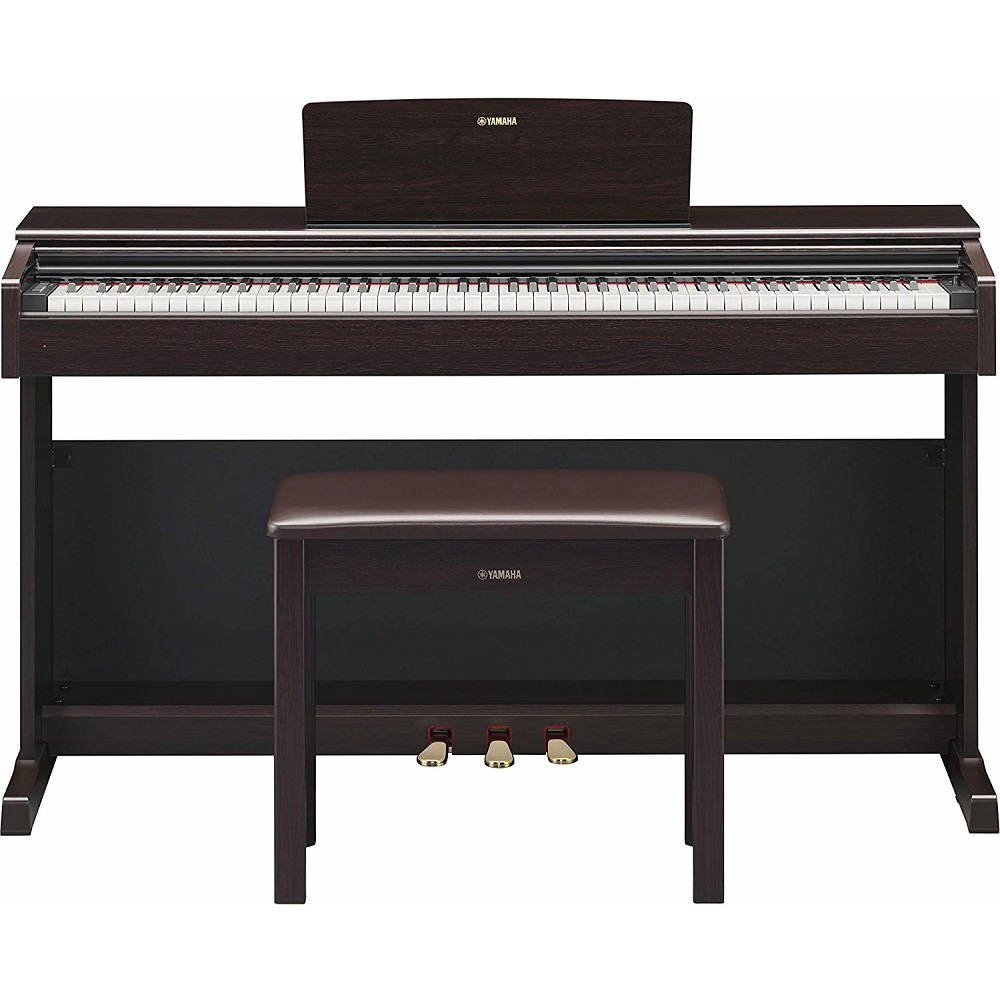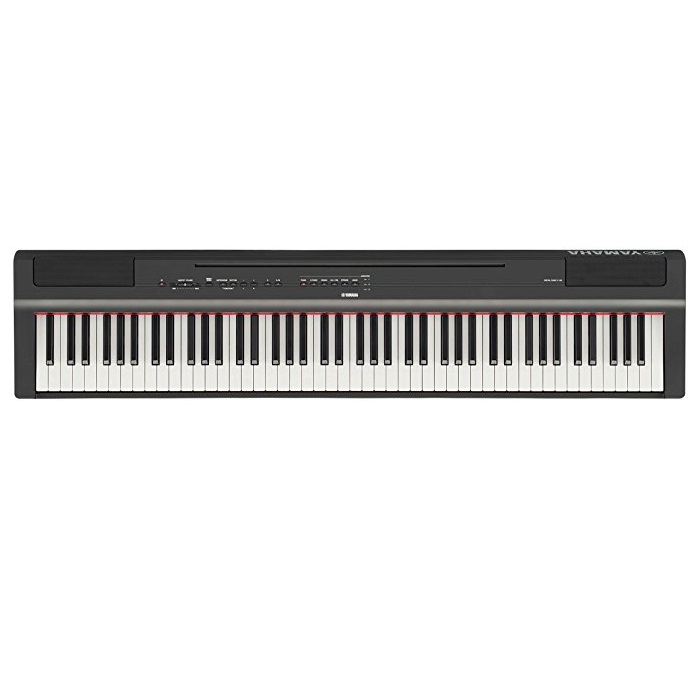You’re probably wondering which one fits your needs best, between the Yamaha YDP-144 vs Yamaha P125. If that is true, then you landed on the right page. I’ve tested both these pianos out so I can make an accurate comparison and help you determine whether a portable piano such as the P125 or an upright piano such as tthe YDP-144 are a better choice for you.
Both digital pianos are newer versions of two models that have been very popular in recent years. They have been so beloved because they packed a lot of advantages and had certain features that beginner and intermediate pianists were searching for. How are these new models comparing to their popular former versions, and especially how are they comparing to one another? This is the question you will find the answer for in this article.
Before analyzing these two digital pianos in matters of design, key action, sound and other aspects, take a look at the table below. It helps you gain an overview as to how these two pianos compare to one another:
If you click the links below, under the product images, you will be redirected to Amazon.com. In case you then decide to buy anything, Amazon.com will pay me a commission. This doesn’t affect the honesty of this review in any way though.
Yamaha YDP-144 vs Yamaha P125 Comparison Chart
| Model | Yamaha YDP-144 | Yamaha P125 |
| Image |  |  |
| Sound Engine | Sampled | Sampled |
| Key Action | Weighted in Blocks GHS | Weighted in Blocks GHS |
| Key touch/weight | 4 levels | Plastic feel, 4 levels |
| Voices | 10 | 24 |
| Polyphony | 192 | 192 |
| Speakers | 8W | 7W |
| Click here to check price on Amazon | Click here to check price on Amazon |
Design
Judging by design, these two digital pianos couldn’t be more different.
The Yamaha P125 is a portable digital piano, designed primarily for the beginner or intermediate pianist who plans on transporting the piano, to piano lessons for example. This can be easily determined by the compact measurements and low weight. Although there is a furniture type stand you can buy for the P125, it doesn’t come as a basic feature. The controls are found on the dashboard above the keys, starting from approximately the middle and going towards the left hand side.
The Yamaha YDP-144, on the other hand is designed for home use. Compared to the previous model, the design hasn’t changed much overall. It has built in stereo speakers and a full 88-key keyboard. It’s just what you need for home, or anyway use in a fixed location. The dimensions are certainly not recommending it for transportation (it is a cabinet style digital piano), and its weight neither. It ways 83 pounds, which makes it pretty uncomfortable to move move around.
Although it has greater dimensions and weight compared to the portable P125, the YDP-144 has a slim design (considering it’s a console piano). If you gravitate towards a console piano but feel like it’s taking up too much of your space, you can also check out the Yamaha YDP-S32, which has the same characteristics as the YDP-144 but comes in a more compact overall design.
Like with all other console digital pianos, in contrast to the plug-and-play P125, you will have to assemble it when it arrives. But, don’t lose your enthusiasm, if you ever ordered a piece of easy assembly furniture, you should know that this will not be any more difficult than that. It comes with all the instructions you will need to assemble it without encountering any difficulties.
So, as far as design is concerned, the Yamaha P125 vs Yamaha YDP-144 battle is almost like comparing apples and and tomatoes. They’re both full size, 88-key digital pianos, but they are designed for different types of uses: portable vs home use.
Sound
The only similarity between the Yamaha YDP-144 and the Yamaha P125 in matters of sound is the way they render the sound. Both use sound samples from acoustic pianos. But this is also where the similarities stop.
The P125 uses the already standard Pure CF sound engine, whereas the YDP-144 has a different, improved sound engine, the CFX. Yamaha used to install the CFX sound engine on their Clavinova line, which is superior to the Arius line of which the YDP-144 is a part of). Discovering that they fitted the YDP-144 with the CFX sound engine was really a very pleasant surprise. Much more so, considering that it’s a digital piano destined especially for beginners. It’s also a big improvement on the predecessor, maybe the biggest improvement according to my opinion. The predecessor uses the some sound engine as the P125.
Although there’s a debate about which type of sound engine is superior, the sampled or the modeled. When I compared the Roland FP-30 vs Yamaha P125, I said that I think the sound of the modeled FP-30 is superior. I keep my opinion, but compared to the superior CFX sampled sound engine, the comparison is kind of even. The sound of the YDP-144 is surprisingly close to the real thing.
Despite having only 10 voices versus the 24 different voices of the P125, those 10 voices are very high quality. Depending on whether you need those extra voices or not, this might or might not be a deciding factor for you.
Speakers
As far as speakers are concerned, there’s not a big difference between the Yamaha YDP-144 vs P125.
The main difference between the two speaker systems is 1W power per speaker. That brings us to a grand total of 2W power difference between the two digital pianos.
This is certainly enough for home use, or even for smaller events. Keeping in mind that one is a home console piano and the other a portable but still bottom of the line digital piano, the speaker systems are not that bad. They are actually pretty good.
Of course, if you want to use any of these two in bigger events, you will definitely need some type of amplification. But the speakers that are installed on these two pianos are bu any not under the level of their category.
The sound is nice, clear and loud enough, but if you want even better sound, you can use headphones anytime. The headphones will block out any exterior noise so that you can hear solely the sound coming from your piano. If you are a beginner, but not necessarily, and practice a lot, I recommend you spare the rest of the household from the repeating music and use a pair of headphones.
Keyboard
Both digital pianos have the Graded Hammer Standard key action from Yamaha. It’s their basic key action. It’s not bad at all, but they can do better, I know that now.
I must say that I’m pretty surprised they didn’t upgrade the key action on the YDP-144. It’s the same key action as found on its predecessor. The new model would have made a much better impression if they did an upgrade on the key action, just like that on the sound engine. This is why I said earlier that the sound engine is the biggest improvement on the former model. But then again, they probably wanted to justify buying the higher end models of the line in some way, for those that are looking for even more refined characteristics.
Apart from that both digital pianos that I compare today have full 88-key keyboards with 4 levels of touch sensitivity. That is soft, medium, hard or off. They also have plastic keys without the ebony and ivory feel tops, but the risk of your fingers sliding off the keys when playing longer is reduced by the matte finish. It’s not as good as the ebony tops but it offers pretty good grip when your fingers start to sweat.
Functions
Looking at the Yamaha YDP-144 vs Yamaha P125 from a functions point of view, I can’t see a lot of difference either. They both have all the basic functions you would expect from a modern digital piano, without having too many bells and whistles. You can record what you play so that you can listen to it later on and take note of any mistakes that you make. This, together with other functions such as metronome are very helpful for beginners. Not so spectacular for more advanced pianists, though.
What I really think is a big advantage and very attractive feature of both digital pianos, is the Yamaha Smart Pianist App.
Unless you have an Apple device you unfortunately can’t use this app, but I’m sure an Android version is in the making. So, if you have an Android device, don’t worry, you will probably be able to use this app in the near future.
The Smart Pianist App helps you integrate your phone or tablet (I prefer the tablet because it has a bigger screen), so that you can use it with the YDP-144 or the P125. Besides having the capability to control all of the piano’s functions from your touchscreen, which is an obvious thing, there’s a very interesting feature that you can take advantage of only with this app. I’m talking about the Chord Chart. This function analyzes any musical piece you enter and displays chords on the screen so that you can easily learn to play that piece.
How cool is that! It not only makes playing the piano a lot more fun, but you can also impress your family and friends by playing their favorite songs.
Connectivity
As far as connectivity is concerned, both digital pianos have headphone jacks and USB connection capabilities.
You don’t have Bluetooth connection on neither of these two models, so if you want to transfer recordings from the piano to a memory device you’ll have to use the USB connection.
Apart from these standard connectivity elements, you have a pedal unit jack. The YDP-144 comes with cabinet and dedicated 3-pedal system, but if you want pedals with the P125, you will have to buy them separately.
In the connectivity department, I can’t say that either of them offer any spectacular features. You can basically find what you would expect from a contemporary digital piano, but nothing fancy or cutting edge. Many time, on the other had you will probably not need any fancy connectivity options because you’re probably not a composer, but a beginner or intermediate musician, looking for an instrument to learn on or use in a home setting.
Conclusion
This is the part where we take a birds eye view over all the points we made during this comparison and decide upon a winner in the Yamaha YDP-144 vs Yamaha P125 battle.
What makes these digital pianos very similar are the full 88-key weighted keyboard, the functions and connectivity capabilities.
The differences are in the design and sound categories. The YDP-144 is a console digital piano meant for home use, or in a fixed place, whereas the P125 is a portable digital piano, compact and light enough to be transported easily. The sound engine on the YDP-144 is superior. It’s the same sound engine found on the Clavinova series from Yamaha.
Taking all these assessments into consideration, I recommend you g for the Yamaha YDP-144, unless portability is a deciding factor for you.
If you want more information on any of these two digital pianos check out my full Yamaha YDP-144 review or the Yamaha P125 review.
